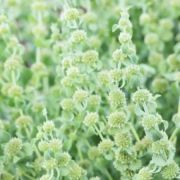Botany Spot – White Horehound
Harvest Article – Autumn 2015
Botany Spot by David Millin
Marrubium vulgare (white horehound) is a common pasture weed of the Lamiaceae family native to Europe, west and central Asia, and North Africa. It was introduced to Australia and New Zealand in the nineteenth century as a medicinal herb.
It is a woody-based perennial with multi-branched stems and grey green leaves that resemble mint. It can grow to be 80 cm tall. The flowers are white and grow in dense whorls in the leaf axils. Post-flowering there is significant dieback after setting seed, and the flowers turn to burrs that are spread in the wool and fur of grazing animals. It spreads easily in disturbed or overgrazed pasture and due to its bitter taste is unpalatable to livestock. In southern Australia it is considered a noxious weed.
It has been used since ancient times as a remedy for coughs and sore throats and as an expectorant. It has been listed as a remedy for expelling worms in farm animals, and modern scientific studies have been conducted on the usefulness of horehound. For example, a 2011 study concluded that the essential oil of M. vulgare contains potent antimicrobial and anticancer properties, while a 2012 study found marrubiin, one of the primary active compounds found in horehound, to possess “antidiabetic, anti-atherogenic and anti-inflammatory properties.” It is also used in the manufacture of horehound candy and horehound beer.
At Weleda, Marrubium is used to produce our Cough Elixir remedy. We harvest the leaf and soft fleshy stems prior to flowering in the spring, when leafy growth is at its maximum. These are then dried and stored until needed. In the manufacturing process, Marrubium leaf is decocted in boiling water, along with various other herbs that are useful in treating cold and flu symptoms, such as plantain and thyme.


